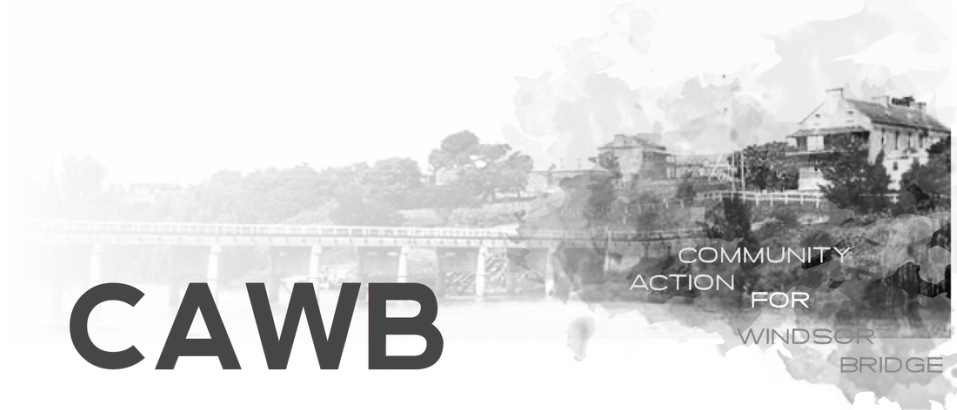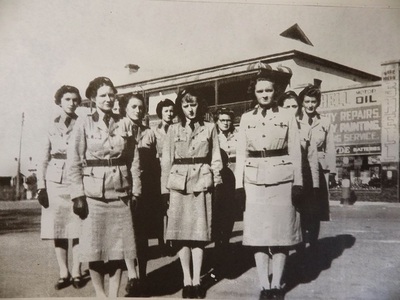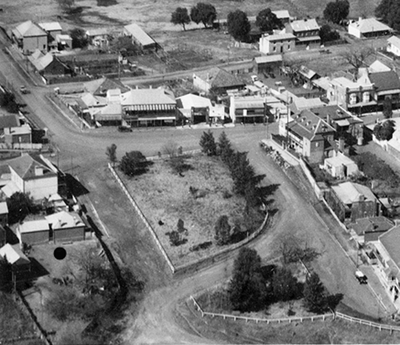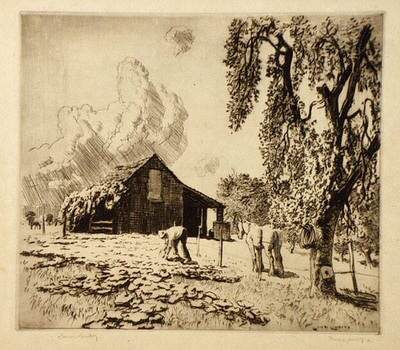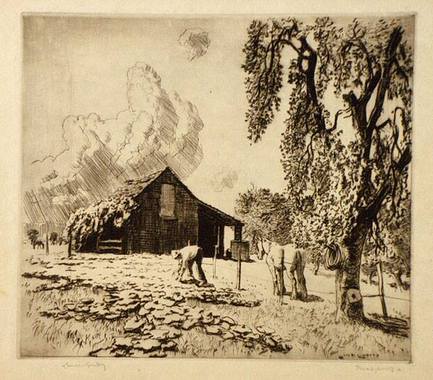
What follows is the story of "the Armstrong century" in Thompson Square. In the next chapter we will meet Roma Armstrong, however, before we proceed we must pause and pay our respects to Roma.
VALE
It is with great sadness that we(CAWB) must report the recent death of Miss Roma Armstrong. She was the inspiration for finding the story of No 6 Bridge Street and she gave willingly of all she knew to help enrich that history.
Roma Armstrong was a great and gracious lady. She had so much presence and was so “with it”....she impressed with her strength of mind and her directness. I am very grateful to have had the opportunity to meet with her. When she spoke of the life she had lived, one was aware they were speaking to “history” and “history” was speaking back...informing, explaining, showing and answering the questions that one had formulated. Her stories were so vivid and so real and told with expression and feeling. I only wish I had known more so I could have asked better questions. And she would have answered them. God love her. She will be greatly missed by all who knew her. May these stories of the Square and in particular, of No 6 Bridge Street, stand as memorial to her spirit.
No 6 BRIDGE STREET - THE ARMSTRONG CENTURY ( 1913 – 2013 )
The little cottage at No 6 has silently witnessed so much of the history of the Square yet it sits there almost unnoticed.....it is listed as being built about 1860 and as giving “character” to the precinct of the Square. The thing is, it was full of “characters” who gave their lives to the Square.......
In 2013, just as the occupation of the Square by CAWB was well underway, there came to an end a 100 year continuous occupation of Thompson Square by the family Armstrong. The story of the Armstrong century of occupation began way back 1913 when the house of the late Mrs Hopkins was offered for sale......
In November, 1913, the following advertisement appears in the Gazette .... “at 2:30 pm at the Royal Hotel, Windsor, the Auctioneers will submit that substantially built cottage and outbuildings, lately occupied by the late Mrs Hopkins. The cottage is a desirable home built of brick containing 4 lofty rooms, kitchen, pantry etc. together with large shed at rear and large stables with lofts and mangers etc; also a roomy yard and nice allotment of land adjoining. The property is so well known that further comment is unnecessary.”
The young Leo Armstrong, farmer on the Peninsular, had long admired the cottage, and it was perfect as a home for his young wife, Jessie whom he had married in 1910. He purchased the cottage for 300 Pound and he and Jessie, who had previously lived elsewhere on the Peninsular moved into the home where they would have three children – Allen, Joyce and Roma.
The Armstrong folk were old and respected inhabitants of the area, originating from a marriage, in 1828, in St John’s Wilberforce, between two convicts – John Armstrong (by the “Hillsborough” 1799 ) and Catherine Mangan ( by the “Almorah”, 1824 ). Leo descended from one of their sons, John, and his son, John Sylvester Armstrong, who was a farmer on the Peninsular, Windsor.
Leo was a man who loved his family, his profession of farming and who was, as a passionate member of the Fire Brigade, a protector of his much loved community.
As a farmer, he worked his father’s land on the Peninsular and upheld the long tradition of providing food for the city of Sydney. Windsor, with it’s rich flood-plain soils, had first been established to feed the fledgling starving colony of New South Wales as it clung desperately to the shores of this new land and the town and district had not strayed far from that original aim. He grew the best and biggest pumpkins in the District, carrying off the top prize at the famed Hawkesbury Show many years in a row for his produce. In 1928 he had everyone puzzled with with his winning specimen of pumpkin and he carried off 1st and 2nd prize for the fourth year in a row. His daughter, Roma, remembers riding home from school on her bicycle and racing down to her father in the paddock to see what jobs he might have for her. Sometimes she and her siblings were sent in the row boat to gather in the pumpkins that had floated off into the river.
When WW2 came along it impacted on Windsor, which as a major food producer, had an important role to perform. Leo’s expertise as a farmer was called upon and he worked with the American Army by giving advice on the growing of corn. In the May Issue of “Yank Down Under”, the magazine published for American troops in Australia and the Islands, an article dealing with sweet corn appeared accompanied by a photograph of Leo, referring to him as a “champ grower”, discussing with an American expert his yield of 5 tons per acre and how he managed to achieve such outcomes. During the War, Leo sold his corn to the Rosella Factory in South Windsor. Roma remembers that corn cobs and dried orange peels worked well in getting the fire started in the copper.....one of her favourite jobs that she happily carried out for her mother.
Both the Armstrong girls joined the Land Army during the War with Roma working on the farm and Joyce driving trucks. It was the girls of the Land Army who harvested Leo’s magnificent crops of corn.
Farming was an important part of the mainstream economy in the days of Leo Armstrong. Evidently, the farmers would gather at night at “the Farmers’ Club Room on Dickson’s Hill” ie. up on the top floor of the Royal Hotel. A journalist wrote a poem in 1905 in tribute to this nightly meeting and in it he mentions Leo and his father “..... Leo Armstrong, just returned from a “Swill”, Now takes his place at the Club on the Hill, And expresses the hope that pumpkins will Bring plenty of grist to the farmer’s mill! .......Jack Armstrong talks of what might have been, And the smashing crops that we’d have seen, Had there but been but a few days between The time the spuds were ripe and green!........”
Leo loved his community and his farming so much that he only ever took one holiday in March 1932 to Manly. But it appears he did not stray far from home because during his sojourn at the seaside he met ex-sergeant Morgan, formally of Windsor, and many other district folk.
The Images attached to this story are as follows :- * Image 1 is of the Windsor Land Army photographed in Thompson Square with the Moses building and the garage in the background. The girl on the far left, back row, is Joyce Armstrong and it is believed Roma is in the front row on the far right.
* Image 2 is an aerial view of Thompson Square, 1929. No 6 Bridge Street is on the left and is marked with a black dot. At the top of the image in Bridge Street is the Carrington ( Jolly Frog ).
* Image 3 is a drawing by Lionel Lindsay of a farmer of Windsor, growing pumpkins. As Lindsay spent some time recording images in the Square, perhaps he wandered the short distance down to the Peninsular and spied Leo Armstrong among his pumpkin patch, just as Roma did when she rushed home from school to join her father in the business of farming.
In the next episode we will ride on the fire-truck with Leo and his fellow firemen on some of their many dangerous missions.
TO BE CONTINUED..........
VALE
It is with great sadness that we(CAWB) must report the recent death of Miss Roma Armstrong. She was the inspiration for finding the story of No 6 Bridge Street and she gave willingly of all she knew to help enrich that history.
Roma Armstrong was a great and gracious lady. She had so much presence and was so “with it”....she impressed with her strength of mind and her directness. I am very grateful to have had the opportunity to meet with her. When she spoke of the life she had lived, one was aware they were speaking to “history” and “history” was speaking back...informing, explaining, showing and answering the questions that one had formulated. Her stories were so vivid and so real and told with expression and feeling. I only wish I had known more so I could have asked better questions. And she would have answered them. God love her. She will be greatly missed by all who knew her. May these stories of the Square and in particular, of No 6 Bridge Street, stand as memorial to her spirit.
No 6 BRIDGE STREET - THE ARMSTRONG CENTURY ( 1913 – 2013 )
The little cottage at No 6 has silently witnessed so much of the history of the Square yet it sits there almost unnoticed.....it is listed as being built about 1860 and as giving “character” to the precinct of the Square. The thing is, it was full of “characters” who gave their lives to the Square.......
In 2013, just as the occupation of the Square by CAWB was well underway, there came to an end a 100 year continuous occupation of Thompson Square by the family Armstrong. The story of the Armstrong century of occupation began way back 1913 when the house of the late Mrs Hopkins was offered for sale......
In November, 1913, the following advertisement appears in the Gazette .... “at 2:30 pm at the Royal Hotel, Windsor, the Auctioneers will submit that substantially built cottage and outbuildings, lately occupied by the late Mrs Hopkins. The cottage is a desirable home built of brick containing 4 lofty rooms, kitchen, pantry etc. together with large shed at rear and large stables with lofts and mangers etc; also a roomy yard and nice allotment of land adjoining. The property is so well known that further comment is unnecessary.”
The young Leo Armstrong, farmer on the Peninsular, had long admired the cottage, and it was perfect as a home for his young wife, Jessie whom he had married in 1910. He purchased the cottage for 300 Pound and he and Jessie, who had previously lived elsewhere on the Peninsular moved into the home where they would have three children – Allen, Joyce and Roma.
The Armstrong folk were old and respected inhabitants of the area, originating from a marriage, in 1828, in St John’s Wilberforce, between two convicts – John Armstrong (by the “Hillsborough” 1799 ) and Catherine Mangan ( by the “Almorah”, 1824 ). Leo descended from one of their sons, John, and his son, John Sylvester Armstrong, who was a farmer on the Peninsular, Windsor.
Leo was a man who loved his family, his profession of farming and who was, as a passionate member of the Fire Brigade, a protector of his much loved community.
As a farmer, he worked his father’s land on the Peninsular and upheld the long tradition of providing food for the city of Sydney. Windsor, with it’s rich flood-plain soils, had first been established to feed the fledgling starving colony of New South Wales as it clung desperately to the shores of this new land and the town and district had not strayed far from that original aim. He grew the best and biggest pumpkins in the District, carrying off the top prize at the famed Hawkesbury Show many years in a row for his produce. In 1928 he had everyone puzzled with with his winning specimen of pumpkin and he carried off 1st and 2nd prize for the fourth year in a row. His daughter, Roma, remembers riding home from school on her bicycle and racing down to her father in the paddock to see what jobs he might have for her. Sometimes she and her siblings were sent in the row boat to gather in the pumpkins that had floated off into the river.
When WW2 came along it impacted on Windsor, which as a major food producer, had an important role to perform. Leo’s expertise as a farmer was called upon and he worked with the American Army by giving advice on the growing of corn. In the May Issue of “Yank Down Under”, the magazine published for American troops in Australia and the Islands, an article dealing with sweet corn appeared accompanied by a photograph of Leo, referring to him as a “champ grower”, discussing with an American expert his yield of 5 tons per acre and how he managed to achieve such outcomes. During the War, Leo sold his corn to the Rosella Factory in South Windsor. Roma remembers that corn cobs and dried orange peels worked well in getting the fire started in the copper.....one of her favourite jobs that she happily carried out for her mother.
Both the Armstrong girls joined the Land Army during the War with Roma working on the farm and Joyce driving trucks. It was the girls of the Land Army who harvested Leo’s magnificent crops of corn.
Farming was an important part of the mainstream economy in the days of Leo Armstrong. Evidently, the farmers would gather at night at “the Farmers’ Club Room on Dickson’s Hill” ie. up on the top floor of the Royal Hotel. A journalist wrote a poem in 1905 in tribute to this nightly meeting and in it he mentions Leo and his father “..... Leo Armstrong, just returned from a “Swill”, Now takes his place at the Club on the Hill, And expresses the hope that pumpkins will Bring plenty of grist to the farmer’s mill! .......Jack Armstrong talks of what might have been, And the smashing crops that we’d have seen, Had there but been but a few days between The time the spuds were ripe and green!........”
Leo loved his community and his farming so much that he only ever took one holiday in March 1932 to Manly. But it appears he did not stray far from home because during his sojourn at the seaside he met ex-sergeant Morgan, formally of Windsor, and many other district folk.
The Images attached to this story are as follows :- * Image 1 is of the Windsor Land Army photographed in Thompson Square with the Moses building and the garage in the background. The girl on the far left, back row, is Joyce Armstrong and it is believed Roma is in the front row on the far right.
* Image 2 is an aerial view of Thompson Square, 1929. No 6 Bridge Street is on the left and is marked with a black dot. At the top of the image in Bridge Street is the Carrington ( Jolly Frog ).
* Image 3 is a drawing by Lionel Lindsay of a farmer of Windsor, growing pumpkins. As Lindsay spent some time recording images in the Square, perhaps he wandered the short distance down to the Peninsular and spied Leo Armstrong among his pumpkin patch, just as Roma did when she rushed home from school to join her father in the business of farming.
In the next episode we will ride on the fire-truck with Leo and his fellow firemen on some of their many dangerous missions.
TO BE CONTINUED..........
